|
|
|
Sort Order |
|
|
|
Items / Page
|
|
|
|
|
|
|
| Srl | Item |
| 1 |
ID:
106796
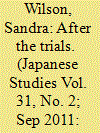

|
|
|
|
|
| Publication |
2011.
|
| Summary/Abstract |
'Lesser' Japanese war criminals, or those in Classes 'B' and 'C', were prosecuted by the various Allied powers in courtrooms around Asia after the Second World War. They were then executed or imprisoned in the places in which they had been tried. By the end of 1953, however, all surviving prisoners had been repatriated to Japan to serve out the remainder of their sentences, and by the end of 1958, all had been released. The decision to repatriate or release prisoners was made by the governments that had tried the war criminals, even after Japan regained its sovereignty in 1952, since the San Francisco Peace Treaty stipulated that the prosecuting countries retained the right to decide on any variation of the prisoners' sentences. The fate of convicted war criminals, therefore, was subject to diplomatic negotiation between Japan and the original prosecuting countries. These negotiations played an important role in the post-war reconfiguration of international relations in the East Asian region. Discussion about the repatriation and release of prisoners constituted one of the first topics of major international negotiation among a reconstructing Japan, the newly independent or decolonising nations of the region, the departing European imperial powers, a United States which was in the process of defining its Cold War aims in the region, and Australian governments seeking to establish a new foreign policy stance in the post-war world.
|
|
|
|
|
|
|
|
|
|
|
|
|
|
|
|
| 2 |
ID:
106797
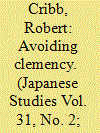

|
|
|
|
|
| Publication |
2011.
|
| Summary/Abstract |
Like other Allied powers in Asia, the Netherlands Indies government embarked on the trial of Japanese military personnel accused of war crimes during the occupation of the Indonesian archipelago. Although calls for clemency towards convicted war criminals were heard as early as 1947, the Dutch authorities resisted the suggestion that prisoners be released or repatriated. Many Dutch residents of the former colony remained bitter about Japanese crimes during the occupation. They also blamed Japanese policies for the insurgent Republic of Indonesia, which at times after its independence declaration in August 1945 controlled large parts of the archipelago. Whereas the rise of communist insurgency in other parts of Southeast Asia, and the broader context of the Cold War, rapidly diminished in those regions the importance of keeping war criminals imprisoned, the Dutch saw their war against the Republic as a continuation of the war against Japan and saw the continued detention of war criminals as essential. When military, diplomatic and political weakness forced the Dutch to recognize Indonesian independence in December 1949, one of their last acts was to arrange the transfer of the remaining imprisoned war criminals to Sugamo Prison in Japan.
|
|
|
|
|
|
|
|
|
|
|
|
|
|
|
|
| 3 |
ID:
106799
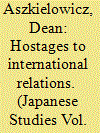

|
|
|
|
|
| Publication |
2011.
|
| Summary/Abstract |
While the Philippines was one of the last of the Allied nations to execute Japanese war criminals, it was also one of the first to allow for their repatriation and pardon. This article examines the period between the last execution of Japanese war criminals in January 1951 and the pardon of the remaining criminals in December 1953, in the context of international negotiations regarding the Philippines' position in the lead up to the San Francisco Peace Treaty and beyond. It traces the development and the strategies of the movement for the repatriation of war criminals in Japan. It argues that the repatriation of war criminals from the Philippines (and elsewhere) became an important domestic political issue in Japan in the period between 1951 and 1953, and that the extent of this domestic pressure was also recognised in the Philippines. In both countries, the repatriation of war criminals was linked in public discourse with progress on the negotiation of reparations, the last obstacle to the resumption of diplomatic relations between Japan and the Philippines.
|
|
|
|
|
|
|
|
|
|
|
|
|
|
|
|
| 4 |
ID:
106800
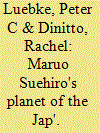

|
|
|
|
|
| Publication |
2011.
|
| Summary/Abstract |
The graphic retelling of history in popular manga, particularly in the work of Kobayashi Yoshinori, has garnered attention in light of the resurgent nationalism of postbubble Japan. This article analyzes the visual-verbal language of cult manga artist Maruo Suehiro's 'Nihonjin no wakusei: Planet of the Jap' (1985). While appearing to revel in a violent depiction of an alternative outcome to World War Two, this manga spans allusions to the Emperor Meiji, the postwar Self-Defense Forces, and the suicides of General Nogi and Mishima Yukio, and aims through its portrayal to critique the links among the Japanese wartime state, contemporary nationalism, fascism and violence. Maruo's consistent use of fascist imagery consciously invites a dangerous voyeurism of traumatic historical events. This is an intentionally political move that forces the reader to realize that complicity in such violent spectacles is a necessary step to critiquing the extreme aggression Maruo attributes to Japan.
|
|
|
|
|
|
|
|
|
|
|
|
|
|
|
|
| 5 |
ID:
106798
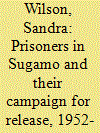

|
|
|
|
|
| Publication |
2011.
|
| Summary/Abstract |
The great majority of Japanese war criminals served part or all of their sentences in Sugamo Prison in Tokyo, either because they had been tried in Japan, or after repatriation from overseas. Once convicted, they tended to be invisible in historical accounts of the post-war period, but in fact they were not cut off from Japanese society or politics in the 1950s. Rather, Sugamo's inmates worked hard to win public sympathy, also exerting considerable pressure on the government in an attempt to hasten their own release and to have Japanese prisoners repatriated from overseas gaols. The early 1950s were crucial, not least because the 1952 peace treaty stipulated that the countries that had originally prosecuted them retained the right to decide on prisoners' fates even after Japan regained its sovereignty. Moreover, convicted war criminals were increasingly concentrated in Sugamo, allowing many opportunities for political activity and other campaigning. Though the last war criminals were not freed until 1958, prisoners' activities in the early 1950s played an important part in changing the terms in which discussion of war criminals took place and thus in making it more and more difficult for foreign governments to maintain their original stance on war criminals.
|
|
|
|
|
|
|
|
|
|
|
|
|
|
|
|
| 6 |
ID:
106801


|
|
|
|
|
| Publication |
2011.
|
| Summary/Abstract |
As a key part of contemporary Japanese mass visual culture, manga has increasingly been used to shape popular perceptions of history. In recent years, there has been a great deal of discussion surrounding politically conservative and revisionist manga that distort the military's actions during Japan's wars throughout the 1930s and 1940s. In regard to the issue of enforced military prostitution, victims, activists, and scholars have found the depiction of so-called 'comfort women' as willing prostitutes or participants to be extremely offensive. Compared to these revisionist works, there are other artists who look to address and faithfully represent and depict the military prostitution issue in manga. Unlike their revisionist counterparts, these artists grapple with the inherent sensitivities of such an issue and struggle with ways to communicate the brutality of gendered violence. These works illustrate important similarities and differences in how artists structure and frame historical narratives in manga. More importantly, the works raise questions about the impossibility of adequately conveying the experiences of soldiers and victims during the war. They also serve as a reminder to the diversity of representations in contemporary Japanese discourse.
|
|
|
|
|
|
|
|
|
|
|
|
|
|
|
|
| 7 |
ID:
106802
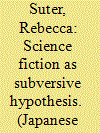

|
|
|
|
|
| Publication |
2011.
|
| Summary/Abstract |
The article considers the literary sub-genre of henkaku tantei sho-setsu, detective fiction that included supernatural or pseudo-scientific elements. Such stories were published regularly in the interwar entertainment magazine Shinseinen, but this was also a journal with an intellectually sophisticated and politically engaged side, regularly publishing essays on the relationship between science and literature, and reflecting the fluidity and constant change of the period in which it flourished. I look at henkaku tantei sho-setsu's combination of rationalism and fantasy, and its oscillation between enthusiasm and anxiety towards modern science, in order to reflect more broadly on Shinseinen's position between ideas of literature as pure diversion and arguments defending its social and educational function. To investigate the specific articulation of these dynamics, I then offer a close reading of one representative work published in the magazine in 1931, 'Robotto to beddo no ju-ryo-', [The Robot and the Weight of the Bed], by Naoki Sanju-go, one of the founding fathers of modern Japanese popular literature.
|
|
|
|
|
|
|
|
|
|
|
|
|
|
|
|
|
|
|
|
|